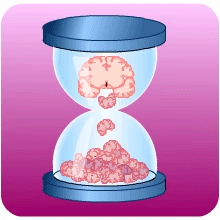
Thrombolysis and/or thrombectomy treatment reduces the risk of residual disability 3-6 months after stroke in appropriately selected patients, even taking into account some early risks. Although the use of thrombolysis is associated with an increased risk of bleeding and death in the first week, there is no overall increased risk of death at 3-6 months.
The chances of a full or nearly full recovery from stroke are much greater the earlier treatment is given. Early treatment within 4.5 hours for thrombolysis, and 6 hours for thrombectomy depends on:
- early recognition of stroke symptoms and taking appropriate action
- streamlining the flow through the in-patient pathway
We aim to deliver thrombolysis within 30 minutes of arrival at hospital (door to needle time (DTN)) in many cases, and almost always within 60 minutes
The main steps on the pathways to delivery of these hyperacute treatments are shown below, along with some timescales.
These times will depend a lot on the geography of the hospital. The aim is to give the bolus of thrombolysis as soon as possible and certainly within 60 minutes from arrival at hospital.
First symptom to decision to call 999
This varies greatly depending on whether the symptoms are recognised as being important, and whether the patient, or their family is aware of the FAST campaign. Delays at this stage are the most common reason why hyperacute treatment cannot be given.
Ambulance arrives
Hyper Acute Stroke is categorised as an ‘Amber’ response by the Scottish Ambulance Service. An amber response call aims to ensure a conveying resource (double crewed ambulance) is on scene within nineteen minutes of the call being received in the Ambulance Control Centre (ACC).
Ambulance leaves scene
The ambulance crew will aim to minimise their time on scene with the patient. They will carry out a number of clinical assessments, including the FAST test before transferring the patient to the ambulance. Currently, time on scene with patients suspected of suffering from hyper-acute stroke is approximately twenty-eight minutes. The SAS continue to work towards reducing time on-scene further to help improve patient outcomes.
Travel time
Travel time to the hospital is dictated by a number of factors, most noticeably, the distance between the scene of the event and the hospital. In some instances, the nearest hospital will be ‘bypassed’ if it is not appropriate to take a suspected stroke patient there due to a particular hospital not being equipped to deliver time critical interventions.
At hospital
All suspected hyperacute stroke patients will be pre-alerted to the most appropriate hospital. This will mean that the patient will be transported under blue lights to minimise any delay and will be taken directly to the resuscitation bay or appropriate area where they will be immediately assessed by Emergency Department medics and/or members of the Stroke team.
Assessment by the Emergency Dept team
The ED team (doctor and nurses), sometimes accompanied by a stroke specialist nurse and during the day a stroke doctor – will be in the ED dept when the patient arrives, if a pre-alert has been received. This greatly reduces delays.
Doctor confirms presentation
The team will check the patient’s observations, elicit onset time (from patient, family of paramedics), confirm the diagnosis of probable stroke with a quick history and neurological examination (based on National Institutes of Health Stroke Scale (NIHSS)) and determine suitability for hyper-acute treatment. They will insert a cannula (probably taking blood though it) to allow contrast and alteplase to be injected if necessary, and arrange the urgent brain imaging. It is not necessary to complete the whole NIHSS if this will delay the imaging.
Transfer to CT scan
The ED team should not wait for porters to do this if it will delay the scan. This delay will vary on the distance between the ED and the scanner. The delay from arrival to scan is often referred to as the “door to scan time”.
CT brain imaging
A non-contrast scan which will exclude a bleed or non-stroke diagnosis will normally take less than 10 minutes including the time taken to get the patient into the scanner. If, as usual, a CTA is done this can add an additional 15 minutes in preparing the injection of contrast, carrying out the additional scans, and reviewing these.
Give bolus of thrombolysis (if appropriate)
This can be delivered in the scanner whilst preparations are made for the CTA. Alternatively, it may be given as soon as possible after imaging is completed in the scanning dept, back in ED or in the stroke unit – this varies from hospital to hospital but clearly it is important to minimise the delay between the imaging and giving the bolus (so called “Scan to needle time”).
Start the Infusion of Alteplase (if appropriate)
The infusion of 90% of the total dose should be started as soon as possible after the bolus, but will need to be delayed until after the CTA.
Start thrombectomy (if the CTA has shown a large artery occlusion)
If the patient is already in a thrombectomy hub it may take as little as 30 minute to organise consent (where possible), GA or awake sedation, and move the patient to the angiosuite for the procedure. However, delays will be much longer where an inter hospital transfer is required. The delay between arrival at the thrombectomy hub and the start of the thrombectomy is sometimes called the “Door to puncture (DTP) time”.
Achieve reperfusion
Sometimes the blocked artery can be opened within 10-20 minutes of starting the procedure. However, in more complex case the procedure can take 60 minutes or more. The delay from arrival at thrombectomy hub is known as the door to reperfusion time.


